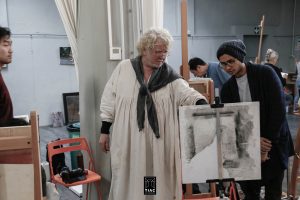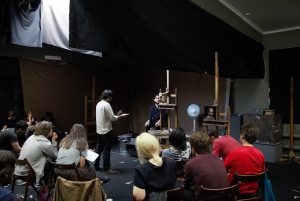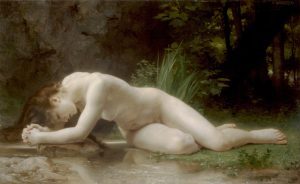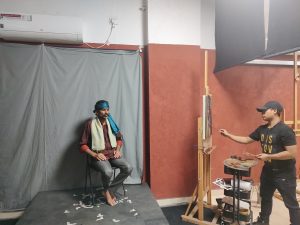Published Sep 19, 2022 | 10:00 AM ⚊ Updated Sep 19, 2022 | 12:48 PM

Ayuesh Agarwal (fourth from left) and others present their works at the Barcelona Academy of Art (Supplied)
The year was 2014. Ayuesh Agarwal was helping his father during the day in his scrap business owing to a financial crunch.
Then a budding artist, he had lost touch with renowned figures in the field he had met during his time at the Florence Art Academy (FAA) in Sweden.
Not even in his wildest dreams did he imagine that five years later, in 2019, he would start an atelier art school in Hyderabad. His Samsara Academy of Art in the city’s upscale Banjara Hills has been approved by the Art Renewal Center, a US-based educational organisation dedicated to realist art.
“During my time at FAA, I learned so much that I wished there was a similar place in India where I could practice. In that way, I would not have had to settle away from my family. And I wouldn’t have to spend so much abroad,” Ayuesh told South First, adding that the idea was always in the back of his mind but he did not know when to execute it.
It was a conversation with noted American artist and filmmaker Ian McCaig that pushed Ayuesh to take art seriously.
“During my time at Los Angeles Academy of Figurative Arts (LAAFA), he asked me why I was there and what my plan was. My response was that I wanted a job. He countered that if I was at LAAFA for a job, then I was doing art for the wrong reasons as it should be my passion and love,” Ayuesh remarked.
An atelier is a private workshop or a studio of a professional artist. There, the master artist and his students or apprentices work together and produce fine art or visual art.
“It has been derived from nature and life. How do you see an object with your naked eye and then design it on paper using your skills and perspective? Translating it on paper and making it look like it exists is a difficult thing to do. Your eye needs to be trained properly along with the technique. Forms in nature are beautiful and complicated at the same time, so you need to analyse them sharply, ” Ayuesh explained while asking a student to add balance to the shapes in his portraits.
While intensive drawing along with painting is the backbone of atelier and even fine arts, students often move to plaster casts (sculptures) made up of plaster of paris (POP).
Materials used in an atelier include sandpapers, charcoal, graphic pencils, blades, oil paints, various types of brushes, oil paints including turpentine oil, a mirror to analyse drawings, and easels (drawing board stands).
The historical purpose of an atelier has been to record events.
“Before the invention of photography, the purpose of the artist in painting, sculpture, and even other forms of classical art was to record events, biblical stories, and help us understand people’s lives and cultures. Artists used to draw portraits of kings and queens. If there used to be a war, they would set up a studio, call the model, go to the field to study the landscape, and then bring all elements together to convert it into a story,” the Hyderabad-born artist said.
He added that, during earlier times, atelier training used to take 7–14 years as logistics was not readily available before industrialisation. “Artists had to do everything on their own. They had to grind the paint, make canvases and other things,” he said.

Ayuesh receives feedback from master painter Odd Nerdrum during a master workshop at TIAC Academy in Florence. (Supplied)
For Ayuesh, it all began with his love for video games and drawing, when he was around eight to nine years old.
“My family wanted me to go for traditional courses like BCom and MBA but I talked them around after Class 12. I was interested in pre-production, such as character designing in a video game. So I discovered the art behind it and enrolled myself in international animation courses,” he recalled.
During these courses, he came across some renowned artists who suggested atelier, significant for learning fundamental art skills, over animation. “I quit my job as a UI designer in a game studio in Hyderabad,” he recollected.

Students, including Ayuesh, attend a demo with painter Jordan Sokol at the Florence Academy of Art. (Supplied)
The obstacles in his journey, however, did not end here as established atelier academies in Europe and the US were not accepting international students.
“After applying for every atelier school in Europe and the US, aged 18–19, I applied to FAA in Sweden in 2013 as they were accepting international students. Luckily I got in and studied there for a year,” Ayuesh said, adding that what he learned in three weeks in FAA took a year in India.
After returning to India, things did not fare out as planned and Ayuesh started helping his father in his scrap business.
While missing his art days, Ayuesh started applying to art academies again and managed to get into LAAFA.
“At the LAAFA, it was more about entertainment design with a direct approach towards video games. But we used traditional mediums like drawing in front of live models and portraits. Thus I honed my skills,” Ayuesh said.
He tries to impart the same skills to his students but does not meddle with their perspectives.
“I keep learning from my students as at times they come with ideas and questions for which I have to research properly before getting back to them,” Ayuesh observed. He ensures that every student gets his equal attention as he visits them turn by turn and inspects their portraits.
After a year at LAAFA, Ayuesh’s goal shifted from entertainment design to fine art. He then transferred to the Barcelona Academy of Art (BAA) in Spain as Los Angeles was very expensive.
After six months of studying at BAA, he started receiving scholarships. His initial plan was to stay there a year as that was the period he had funds for but it ended up being a two-and-a-half-year affair.
“I got the opportunity to teach, work as a studio assistant, and write a blog. That’s how I kept getting more scholarships and they extended my stay,” Ayuesh said.
During this time, he started selling some of his works. “I also applied for a competition at the European Museum of Modern Arts, a figurative competition known as figurativas [in Latin]. My work fortunately got selected among the top 100 and was bought for their permanent collection.”
Gerard Castellví, artist and principal instructor at the Barcelona Academy of Art, told South First that that Ayuesh was a student who had a really clear idea why he was there.
“He [Ayuesh] was one of the most dedicated, if not the most dedicated, students in the academy back then. He was professional since the first day. He was passionate in learning any new concept or step that would make him better. Definitely the type of students that became a model for others students in the academy,” Gerard said.

Gerard, his teacher in Barcelona, said, “His passion and generosity in sharing knowledge with the rest of the students was so clear from the beginning that we all knew he would become a great teacher. He was also ready to help the teachers with any aspect any time. His opinions gained respect among us to the level we were thinking of him as an equal. That’s how he became a teacher even before graduating.”
Ayuesh called his time in Barcelona eye-opening. “It still helps at every step. I was inspired by the director Jordi Diaz Alama’s work, perspective, and passion. It compelled me to ponder on what McCaig told me at LAAFA.”
It was then that he had the idea of setting up a small studio in Hyderabad as he wanted to return to his home in the Nampally area of Hyderabad.
“Whoever wanted to learn a tiny bit from me was welcome but there was never an intention to set up an academy like this,” Ayuesh said and revealed his plan of extending the ground-floor academy to two storeys.
There are 19 students at the academy at present from different parts of the country. Satanu Mukherjee (20) from Kolkata was of the view that the approach and technique followed at Samsara is better than that taught at other fine arts or visual arts institutions in India.
“Ayuesh sir brings a lot of unique methods as he practised with some of the best atelier artists on planet during his time abroad. This is not the case with other fine arts institutes in India as the training there is not as rigorous,” he told South First.
With around 10 years of experience in the field now, Ayuesh is now displaying his works abroad.

Painting of a female lying on the grass — titled Byblis — by the great 19th-century French painter William Adolphe Bouguereau. (Supplied)
“I exhibited in ERA Contemporary gallery in Philadelphia and also won prizes through jury shows in Barcelona, New York, and Florence. I try to draw every day, if not physically, in my mind,” he noted, adding that even if his schedule is busy, he still manages to record his ideas in his sketchbook after reaching home.
Ayuesh constantly draws inspiration from the artwork of noted renaissance painters like Michelangelo, Raphael, Titian, and Rembrandt.
“There is a beautiful painting of a female lying on the grass by the great 19th century French painter William Adolphe Bouguereau in Salar Jung museum near Charminar (Hyderabad),” Ayuesh said and smiled .

Shiva, a farmer from Bhadrachalam town, Bhadradi Kothagudem district in Telangana, posing for the students. (Ajay Tomar/ South First)
Sitting in a semi-circle formation, it is an everyday process for the artists to draw with a person acting as a model right in front of them.
“I ensure that the materials used are of good quality because then the artwork survives for hundreds of years. With bad quality materials, the work can deteriorate very quickly,” Ayuesh pointed out.
At times though, the search for a model turns into a challenge.
“Initially it was very hard but luckily, I came in touch with background artists of the Telugu film industry who agreed to pose. But at times, it’s still a challenge. Sometimes even the daily-wagers come and we make sure that we pay them well,” he narrated while pointing out that the day’s model was a farmer from Bhadrachalam town, Bhadradi Kothagudem district in Telangana.
At Samsara, a model is paid between ₹300 to ₹500 for an hour with a break of five to 10 minutes after every 25 minutes. The session goes as long as three to four hours depending on the time students require to finish their illustrations.
“At times, the models are required to pose semi-naked and naked as we have to study bones, anatomy, and human muscles to understand the principles of art. When I was in Europe, it was easy to find willing models to do such poses. But here, as we know, the atmosphere is different,” Ayuesh said.
“I always ensure that the students pay respect to the model and behave professionally, and keep trying to raise the pay of models,” Ayuesh, also a travel enthusiast, said.
